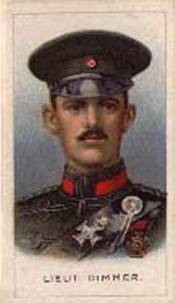Lieutenant John Henry Stephen Dimmer - The Victoria Cross, RUSI and the First World War, Part VI
As part of our series looking into the lives of the RUSI members who were Victoria Cross holders and fell in the Great War, we profile Lieutenant John Henry Stephen Dimmer.

John Henry Stephen Dimmer was born on 9 October 1883 in South Lambeth, London. He grew up in Wimbledon and attended his local school. At age 13, he was awarded a scholarship to attend Rutlish Science School in Merton. In 1902, following a period in the 1st Cadet Battalion, King’s Royal Rifle Corps (Militia), Dimmer joined a regular battalion. He won prizes for drill and shooting, among other things, and served in South Africa. In 1907, Dimmer received thanks from the Army Council for intelligence work conducted. In 1908, he became an officer and spent the years prior to the First World War carrying out ‘special work’ in Africa. In July 1911, Dimmer was promoted to lieutenant.
Dimmer was serving with the 2nd Battalion, King’s Royal Rifle Corps, when he was awarded the Victoria Cross for his actions on 12 November 1914 at Klein Zillebeke, Belgium. Dimmer was in command of four machine guns when an enemy shell took out one gun and killed all except three of his men. The Prussian Guards were attacking from about 100 yards away. Dimmer was injured in the face and was close to passing out, but a nip of brandy from one of his men revived him. Enemy shellfire then left him effectively alone at the machine-gun position. One of his three remaining men was killed, and the other two injured.
Dimmer managed to get to one of the machine guns and fired on the Germans, which focused their fire on him. The ammunition belt of Dimmer’s weapon got wet and jammed. To fix this he had to get up on the gun emplacement and was shot in the jaw. A second jam saw Dimmer repeat the process and he was shot in his right shoulder. Dimmer continued to fire on the enemy. His injured shoulder was hit again by three shrapnel balls from a shell exploding above him. Dimmer paused only drink the remainder of the brandy and the intensity of his fire caused the Germans – by now just 50 yards away – to break ranks and run. Eventually his gun was obliterated by shrapnel in an attack that embedded small pieces of his gun and shell shrapnel into his face. Dimmer collapsed into unconsciousness after having fired more than 900 rounds.
On waking, he refused treatment until he had made his report to Earl Cavan, his commanding officer. Dimmer was sent to the Bellevue Hotel hospital in Wimereux, near Boulogne, France. While recuperating, Dimmer and a fellow officer went out to a local restaurant and bought English newspapers to read over lunch. Dimmer sank back into his chair and the colour drained from his face. His friend, thinking that Dimmer was ill, hastily asked if he was alright. A faint voice responded: ‘It is nothing, but I have just read that I’ve got the Victoria Cross’.
On 13 January 1915, Dimmer was presented with his VC, along with the Military Cross, for devotion to duty on multiple occasions. Dimmer was the first person to be awarded both the VC and the MC in the First World War. He was twice mentioned in despatches. Dimmer was offered the Freedom of the Borough of Wimbledon in April 1915, but refused this offer with humility, writing: ‘Whilst appreciating the great honour, I beg to decline the same. Too much publicity has been given my name already. … To accept the freedom would only bring further publicity, and such is not in accordance with the traditions of the service’.
Dimmer saw further action during the First World War, including at the Battle of Cambrai, November 1917. He was killed in action while leading his battalion at Marteville, near St Quentin, France, on 21 March 1918. Dimmer was buried in France in the Vadencourt British Cemetery, Plot II, Row B, Grave 46. His VC is held by the Royal Green Jackets Museum, Winchester. A colleague wrote of him: ‘[he] was like a father to us, we all had implicit faith in him, and loved him dearly. He was full of energy with a natural ability for military work’.
Ashley Ryan is an RLMH volunteer and 2016 Trench Gascoigne Essay Prize third place winner.
This article is the sixth in a nine-part series to be published in the RUSI Library News.
Past Stories
Part I For Valour: The Victoria Cross, RUSI and the First World War
Part II Captain Charles ‘Fitz’ FitzClarence
Part III Brevet Major John Edmond ‘Johnnie’ Gough
Part IV Captain Francis Octavius Grenfell
Part V Major Charles Allix Lavington ‘Cal’ Yate
If you would like to learn more, go to https://RUSI.org/GreatWar
Bibliography
Kevin Brazier, The Complete Victoria Cross: A Full Chronological Record of All Holders of Britain's Highest Award for Gallantry (Barnsley, South Yorkshire: Pen & Sword Military, 2010).
Gerald Gliddon, VCs of the First World War: 1914 (Stroud, Gloucestershire: Alan Sutton Publishing, 1994).
Paul Oldfield, Victoria Crosses on the Western Front, August 1914–April 1915: A Guide to the Locations – From Mons to Hill 60 (Barnsley, South Yorkshire: Pen & Sword Military, 2014).
RUSI Journal, ‘Great War Stories: RUSI’s Fallen Members’ (Vol. 162, No. 3, June/July 2017), pp. 4–10.
